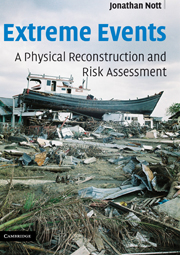Appendix: Dating techniques
Published online by Cambridge University Press: 18 December 2009
Summary
Radiocarbon dating
Radiocarbon dating relies upon the decay of 14C, relative to the concentration of 12C, within an organism after its death. 14C is produced in the upper atmosphere by the bombardment of 14N by cosmic radiation. The 14C is then transported to the Earth's surface by atmospheric activity such as storms and becomes fixed in the biosphere. It becomes attached to complex organic molecules through photosynthesis in plants and animals ingesting those plants in turn to absorb the 14C along with 12C and 13C. When the organism dies, the ratio of 14C within its carcass begins to gradually decrease. The 14C half-life is 5730 years which means that half of the 14C present at the time of death will decay over this time period.
The ratio of 14C to 12C in the atmosphere has not remained constant over time. This is due to variations in the intensity of the cosmic radiation bombardment of the Earth, and changes in the effectiveness of the Van Allen belts and the upper atmosphere to deflect that bombardment. Comparisons between radiocarbon dates and those from other independent techniques such as dendrochronology and coral growth ring chronologies have allowed the development of calibration tables that outline these variations over time. Radiocarbon dates are calibrated against these tables to convert the result from radiocarbon to calendar years.
Cosmogenic nuclide dating
The method is based upon the same idea as radiocarbon dating of 14C produced in the atmosphere.
- Type
- Chapter
- Information
- Extreme EventsA Physical Reconstruction and Risk Assessment, pp. 268 - 270Publisher: Cambridge University PressPrint publication year: 2006



